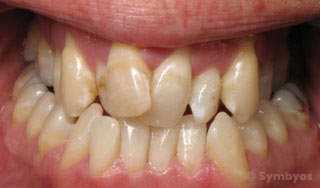Orthodontic treatment

Figure 1: A strong case for the need of orthodontics. This patient has moderately severe crowded upper teeth; mild crowded lower teeth; maxillary arch constriction; teeth in cross-bite; misalignment; and receding gums. (Image courtesy Thomas J. Melcher, DDS, MS).
Patients who have crowded teeth, rotated teeth, or malocclusion (misaligned teeth) may benefit from orthodontic treatment to move teeth into more optimal positions (Figure 1). Crowding and misalignment of the teeth makes it difficult to keep them clean, and puts the patient at risk for dental caries (cavities/tooth decay) and periodontal disease (gum disease). This is because wherever food accumulates, bacteria thrive; and bacteria cause tooth decay and gum disease.
Advanced gum disease (periodontitis) has been shown to contribute to cardiovascular disease (blood vessels of the heart), peripheral vascular disease (blood vessels of the body), poor control of diabetes, and the risk of stroke. It has also been implicated in pre-term childbirth and low birth-weight babies in certain populations.
Malocclusion can accelerate tooth wear (attrition) and increase the likelihood of tooth fractures. It can also cause jaw joint pain and dysfunction (TMD), fatigue/pain in the chewing muscles (myalgia), gum recession (from off-axis forces on the teeth); and can be a contributing factor in improper nutrition.
Moving the teeth and influencing the growth and development of the jaws, such that they align properly and provide proper support for the lips and cheeks is what orthodontists do. Moving teeth orthodontically can be done with fixed braces, adjustable retainers the patient can remove, or rigid acrylic positioning trays.
Influencing the growth and development of the jaw and facial bones may involve use of externally applied forces (for example, headgear appliances), adjustable appliances that are worn in the mouth, dental implants positioned as temporary anchorage devices (TADs) for orthodontic devices, palatal expansion devices, and other mechanisms.
See also on ToothIQ.com